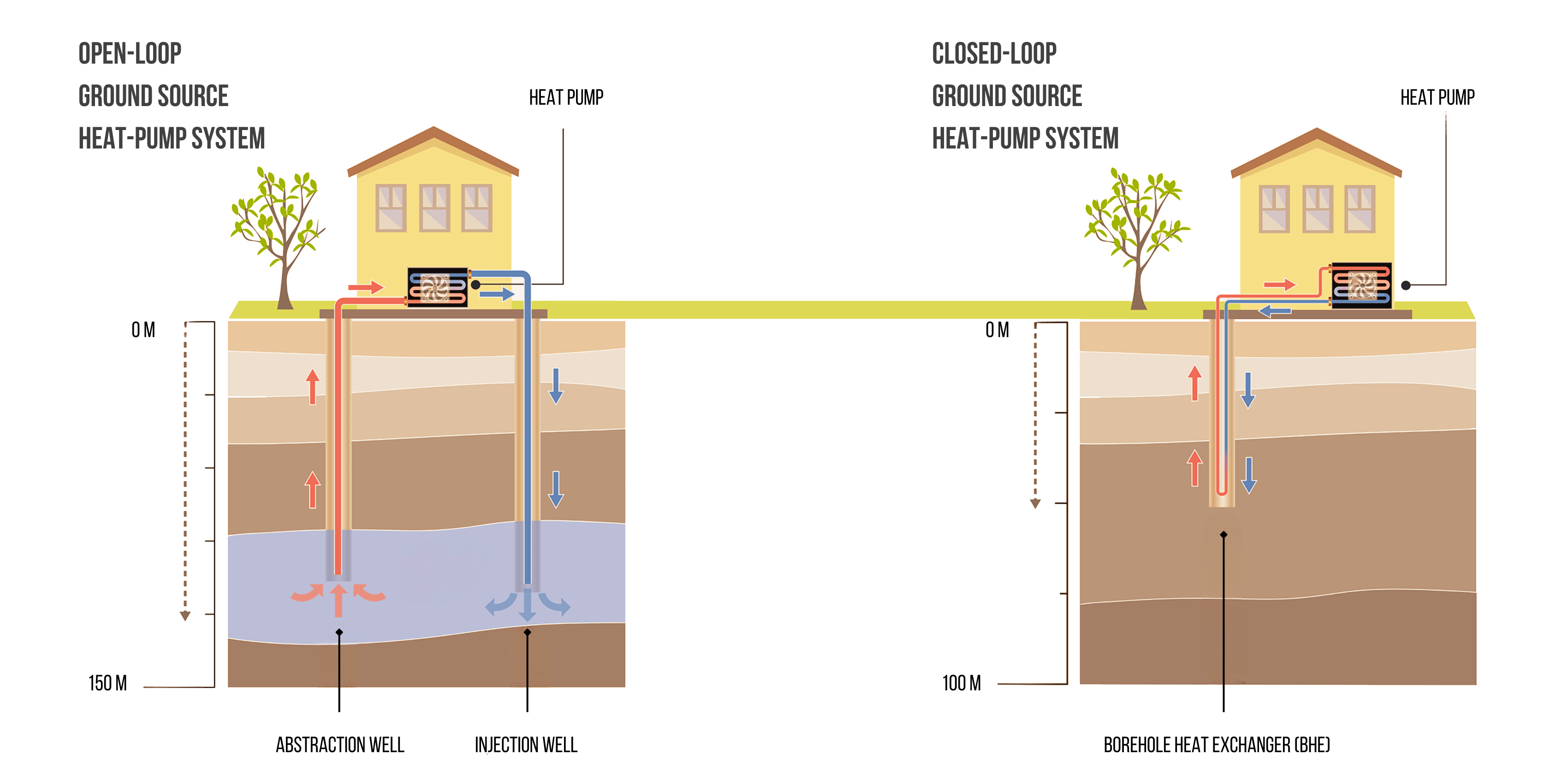

INTELLIGENT ENGINEERING
What is Shallow Geothermal Energy?
When we think of renewable energy sources, wind turbines and solar panels often come to mind. However, there is another clean energy source that is gaining traction in the UK: shallow geothermal energy.
Geothermal Energy is all energy stored in the form of heat beneath the surface of the solid earth. Systems installed at no more than a depth of 500 m to take advantage of the temperature (which is below 100 °C in the case of low enthalpy and below 25 °C in the case of very low enthalpy) are categorised as Shallow geothermal energy.
These systems transfer heat by pumping water or a refrigerant (a special type of fluid) through pipes just below the Earth's surface, where the temperature is constant. They then bring the heat or cold to the surface, where it is extracted by a special electrical device named a “heat pump” and is then transferred to the house/industry domestic heating/cooling system.

How Geothermal Energy is Generated
The ground source heat pump (GSHP) systems can be configured in different ways:
• Open-loop system: Groundwater is pumped directly from aquifers or flooded mines. This type of system uses well or surface body water as the heat exchange fluid that circulates directly through the GHP system. Once it has circulated through the system, the water returns to the ground through the well, a recharge well, or surface discharge. This option is practical only where there is an adequate supply of relatively clean water, and all local codes and regulations regarding groundwater discharge are met.
• Close Loop borehole heat exchanger: Most closed-loop geothermal heat pumps circulate an antifreeze solution through a closed loop—usually made of a high-density plastic-type tubing—that is buried in the ground or submerged in water. A heat exchanger transfers heat between the refrigerant in the heat pump and the antifreeze solution in the closed loop.

How do Ground Source Heat Pumps Work?
GSHP transfers heat by circulating a substance through evaporation-condensation cycles. A compressor pumps this refrigerant between two coils that exchange heat. In one of them, the refrigerant evaporates at low pressure and absorbs the heat from its immediate surroundings. Then, the refrigerant is compressed at high pressure in the other coil where it condenses. At this point, it releases the heat that it absorbed previously. Electrical energy is needed to drive the heat pump, but the process is more efficient than the combustion of gas. On average, one unit of energy input to the heat pump generates 3–4 units of heat output. This gives heat pumps operational efficiencies of 300–400%, compared with an average 85% for condensing boilers.
The heat pump cycle is fully reversible, and heat pumps can provide year-round climate control, offering heating in winter and cooling and dehumidifying in summer. Since the ground and air outside always contain some heat, a heat pump can supply heat even on cold winter days.
What are the Advantages of Geothermal Energy?
While not as widely recognised as some of its counterparts, Geothermal energy presents an important option for the decarbonisation of heat and power, and it could make a significant contribution to reaching Net-Zero targets in the UK.
Among the many benefits of shallow geothermal energy are:
- Always available: heat is continuously produced inside the earth 24/7
- Doesn’t depend on weather conditions
- Consume 25-50% less electricity than most conventional heating and cooling systems
- Low Green House Gases (GHG) emission
- Doesn’t require large spaces for installation
- Requires very little maintenance
Uses of Geothermal Energy
The Department for Business, Energy and Industrial Strategy (BEIS) funded Electrification of Heat Demonstration Project is currently testing the performance of heat pumps in different types of homes. Early results indicate that heat pumps are suitable for all UK housing types.
Heating makes up around a third of the total energy consumption of the UK (according to the latest data from the 2021 British Geological Survey). With more than 80% of domestic heating still delivered by gas boilers, it is responsible for almost 17% of the UK’s carbon emissions. Carbon emissions need to be drastically reduced to enable the UK to meet its Net Zero targets by 2050, and shallow geothermal energy holds immense potential for sustainable heating and cooling solutions in the UK.
Information sources:
The role of regulation in geothermal energy in the UK - ScienceDirect
Geothermal energy - British Geological Survey (bgs.ac.uk)
Shallow geothermal energy potential for heating and cooling of buildings with regeneration under climate change scenarios - ScienceDirect
Geothermal Heat Pumps | Department of Energy
POST-PB-0046.pdf (parliament.uk)
Advantages of Geothermal Energy | Enel Green Power
Analia Scarpanto
EPConsult Energies | INTELLIGENT ENGINEERING
More insights:

Hydrogen Challenges and Solutions
Hydrogen, with a history intertwined with the energy sector for over two centuries, is witnessing a remarkable resurgence, particularly as a renewable energy source in the UK's transition from fossil fuels. As the momentum around hydrogen energy grows, so does the question of its safety. While all fuels inherently pose some risks, hydrogen's unique properties, such as a wide range of flammable concentrations and lower ignition energy, necessitate additional engineering controls and careful material selection.

UK's Electric Vehicle Revolution
In a landmark decision that marked the beginning of the UK's Electric Vehicle (EV) Revolution, the UK government announced in November 2020 the cessation of sales of petrol and diesel-fueled vehicles by 2030, and hybrid vehicles by 2035. This unprecedented shift, aimed at significantly reducing the country's carbon footprint, has set the stage for a monumental transition in the transport sector, which accounted for 24% of the UK's total emissions in 2020.

Blowing Away the Carbon
There are several technical and economic reasons that offshore wind power is a viable option for decarbonizing traditional oil and gas production. Firstly, new offshore wind license areas are often located in deeper waters and at greater distances from the coast. Once land is reached, these sites are still far from potential markets. These logistical factors drive up the cost of delivering power to onshore users.

Common Myths About Solar Energy
The myths and misconceptions surrounding solar energy often need to be updated or stem from a lack of understanding of the technology. Solar energy remains efficient in less-than-ideal weather conditions, and while initial costs can be high, the long-term financial benefits are substantial. Furthermore, although the manufacturing process of solar panels does have an environmental impact, the overall effect is far less damaging than traditional energy sources.

From Coal Mines to Clean Energy
The commitment to net zero has impacted all sectors, promoting the need for low-carbon technologies. Around the UK, a vast number of decommissioned facilities are standing disused in previous industrial hubs, and this will only become more common over the coming years as more and more carbon-polluting facilities are closed. More recently, there has been research and investment on how these sites could be used to develop renewable energy sites.

Riding The Waves of Energy
The ocean is a vast playground of untapped energy. Waves, created by the wind's interaction with the water's surface, hold immense potential. Wave energy, also known as ocean wave power, aims to capture this power and convert it into usable electricity. It's like harnessing the ocean's natural heartbeat to power our world. The energy held within the world's waves is the most significant unused power source on the planet, with the total energy potential globally believed to reach a staggering 30,000 TWh per year. To put this into perspective, that's tenfold the European Union's total annual electricity usage.
- Log in to post comments
